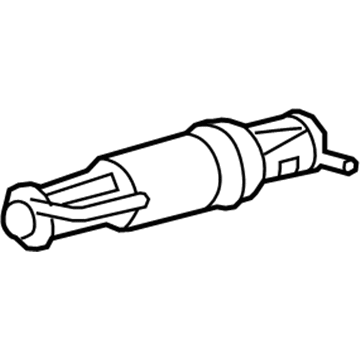FordParts
My Garage
My Account
Cart
OEM 2005 Mercury Mariner Vapor Canister
Fuel Vapor Canister- Select Vehicle by Model
- Select Vehicle by VIN
Select Vehicle by Model
orMake
Model
Year
Select Vehicle by VIN
For the most accurate results, select vehicle by your VIN (Vehicle Identification Number).
3 Vapor Canisters found
2005 Mercury Mariner Vapor Canister Part Number: 7L8Z-9D653-E
$205.44 MSRP: $349.09You Save: $143.65 (42%)Ships in 1-2 Business DaysProduct Specifications- Other Name: Hose - Fuel Vapour; Vapor Canister Purge Solenoid; Canister Hose
- Replaced by: 5L8Z-9D653-BB
- Replaces: 7L8Z-9D653-C, CX-2135, 5L8Z-9S327-AA, 7L8Z-9S327-B, CX-1952, 7L8Z-9D653-D, 5L8Z-9D653-BA
- Base No.: 9G297
- Item Weight: 5.40 Pounds
- Item Dimensions: 7.7 x 7.7 x 24.3 inches
- Condition: New
- Fitment Type: Direct Replacement
- SKU: 7L8Z-9D653-E
- Warranty: This genuine part is guaranteed by Ford's factory warranty.
2005 Mercury Mariner Vapor Canister Part Number: F5AZ-9D653-A
$71.05 MSRP: $116.91You Save: $45.86 (40%)Ships in 1-2 Business DaysProduct Specifications- Other Name: Reservoir Assembly; Vapor Canister Purge Solenoid
- Manufacturer Note: Canister only
- Base No.: 9D653
- Item Weight: 2.00 Pounds
- Item Dimensions: 7.5 x 4.2 x 9.0 inches
- Condition: New
- Fitment Type: Direct Replacement
- SKU: F5AZ-9D653-A
- Warranty: This genuine part is guaranteed by Ford's factory warranty.
2005 Mercury Mariner Vapor Canister Part Number: 5L8Z-9D653-BB
$205.44 MSRP: $349.09You Save: $143.65 (42%)Ships in 1-2 Business DaysProduct Specifications- Other Name: Cannister - Fuel Vapour Storage; Vapor Canister Purge Solenoid; Cannister - Fuel Vapour Store
- Manufacturer Note: Complete Asy - Bracket, Canister And Hoses
- Base No.: 9D653
- Item Weight: 8.50 Pounds
- Item Dimensions: 5.8 x 28.3 x 15.0 inches
- Condition: New
- Fitment Type: Direct Replacement
- SKU: 5L8Z-9D653-BB
- Warranty: This genuine part is guaranteed by Ford's factory warranty.
2005 Mercury Mariner Vapor Canister
If you're seeking quality and affordability, look no further than our extensive inventory of genuine 2005 Mercury Mariner Vapor Canister available at FordPartsDeal.com. You can confidently purchase our OEM 2005 Mercury Mariner Vapor Canister as they are supported by the manufacturer's warranty and our hassle-free return policy, alongside the benefit of our fast delivery service.
2005 Mercury Mariner Vapor Canister Parts Q&A
- Q: How to Service and Repair the Vapor Canister on 2005 Mercury Mariner?A: Start the evaporative emission control canister servicing and repair by placing the vehicle in neutral position with a hoist under it. Disconnect the battery ground cable to reduce the chances of electrical sparks that might cause fuel vapor ignition. Open flames and smoking must be completely avoided in areas where fuel-related parts exist because the components contain highly combustible mixtures. The servicing of the evaporative emission (EVAP) canister vent solenoid requires the removal of its electrical connector together with the fuel vapor hose from the dust separator. The user must squeeze the fuel vapor tube quick connect coupling at the point away from its release tabs to disconnect it from the EVAP canister. Unbolt the EVAP canister assembly by removing two nuts along with three bolts. Replace the new canister by tightening its fasteners to 7 Nm (62 lb-in) while performing the removal steps in reverse order. Precise testing of evaporative emission systems through leak inspections followed by a drive cycle validation process verifies system operation effectiveness after installation.

















